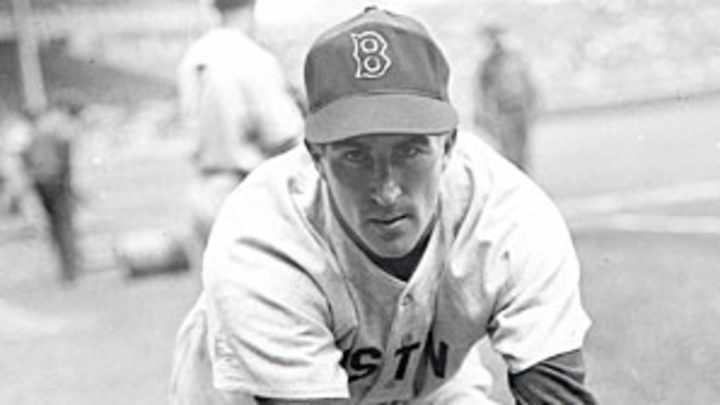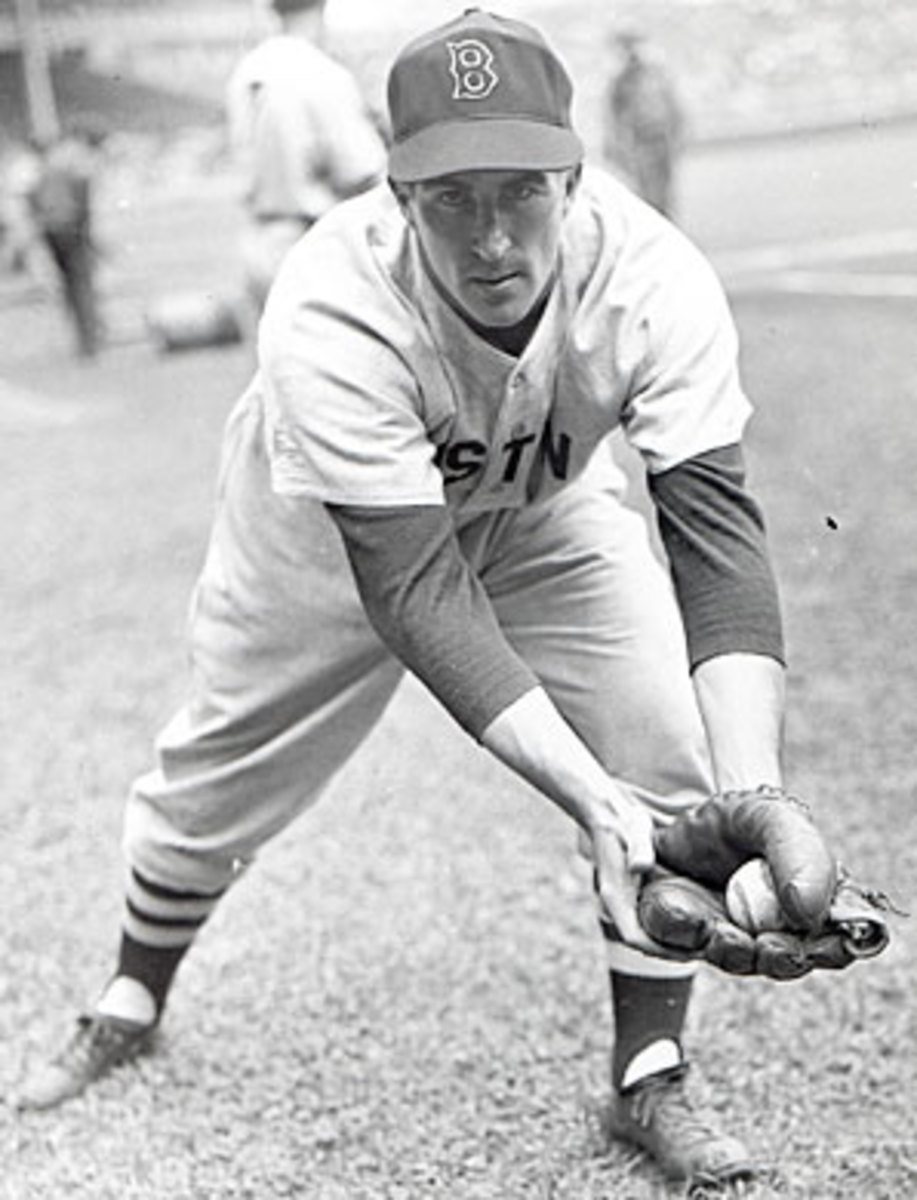Remembering Johnny Pesky

Johnny Pesky was a fixture in the Red Sox' infield in the postwar years, and led the AL in hits during their pennant-winning season of 1946.

The baseball world lost an icon on Monday when former Red Sox shortstop Johnny Pesky passed away at the age of 92. Today, his name is most known in connection with Fenway Park's rightfield foul pole — Pesky's Pole — but Pesky (born John Michael Paveskovich to Croatian immigrants on September 27, 1919) deserves to be remembered for far more than that.
He was an All-Star who collected over 200 hits in each of his first three seasons (topping the AL each time and twice leading the majors), a key player on Boston's 1946 AL pennant winners and a staple of the Red Sox organization. From his signing as an amateur in 1940 to his trade to the Tigers in mid-1952, and then via stints as manager, coach, color commentator and special instructor, he spent over 60 years affiliated with the Sox. Were it not for his World War II service, which cost him his age-23, 24 and 25 season from 1943-45, he might have made the Hall of Fame.
Born and raised in Portland, Oregon, Pesky nearly signed with the Cardinals, who offered a $2,500 bonus. However, Pesky's parents were so impressed with Red Sox scout Earl Johnson that they settled for a $500 signing bonus, with an additional $1,000 to follow if he remained in the organization for two years. During his two years in the minors, he led each of his leagues in hits, and won American Association MVP honors in 1941. He joined the Red Sox the following season as a 22-year-old and hit .331/.375/.416 with a major league-high 205 hits, pairing with future Hall of Famer Bobby Doerr as a standout double-play combination. He was the runner-up to teammate Ted Williams in the batting title race, and finished third in the MVP voting behind the Yankees' Joe Gordon and Williams.
Pesky spent the next three years serving in the Navy during World War II, but when he returned to the Sox, he didn't miss a beat, hitting .335/.401/.427, again leading the American League eague with 208 hits, finishing third in the batting title race and fourth in the MVP voting. More importantly he helped the Red Sox to their first pennant since 1918. Alas, the Red Sox lost to the Cardinals in a thrilling seven-game World Series, and according to legend, Pesky was caught off guard on the Series' deciding play. With the score tied in the bottom of the eighth inning of the final game, the Cardinals' Harry Walker lashed a double to left-centerfield. Surprised by Enos Slaughter running through the third base coach's stop sign to streak home from first base, Pesky hesitated — at least according to some newspaper accounts — allowing what proved to be the deciding run to score. "Pesky held the ball!" became part of the lore, though the film evidence supports Pesky's contention that he didn't hesitate.
Pesky led the majors in hits (207) one more time in 1947, batting .324/.393/.392. But because he had gone homerless and driven in just 39 runs, he was given a 12.5 percent pay cut, from $20,000 to $17,500. "They asked me how many home runs I hit and how many runs I had knocked in," he told biographer Bill Nowlin years later. Indeed, Pesky's low total of 17 career homers — including just six at Fenway Park — suggests the naming of the famous foul pole in his honor is based more on legend than fact. As the story goes, in the 1960s, former Sox hurler Mel Parnell, who was part of the team's broadcasting crew, told a story about a game he pitched in which Pesky hit a game-winning home run around the pole, whose official measurement is just 302 feet away from home plate. In fact, the one time Pesky homered in a Parnell start was in a losing cause. By the shortstop's own recollection, the decisive eighth-inning home run he hit in the Red Sox' 1946 home opener wrapped around the pole. Sixty years later the Red Sox officially named the pole in his honor.
Pesky shifted to third base following the 1947 season after the acquisition of slugging shortstop Vern Stephens from the St. Louis Browns. His numbers tailed off a bit, but he recovered to post batting averages above .300 and on-base percentages above .400 in each of the next three seasons, and even reclaimed his shortstop job in 1951 ahead of future Hall of Famer Lou Boudreau, who had been let go by the Indians the previous winter. But after a slow start in 1952 — and with Boudreau now managing — the 32-year-old was traded to the Tigers as part of a nine-player deal. He spent just one full season in Detroit before being shipped to the Washington Senators early in the 1954 season, but he played sparingly.
Cut by the Orioles the following spring, he retired as a player and moved into minor league coaching in the Yankees organization. He spent five years as a minor league manager in the Tigers' system, and two more in Boston's before being named manager of the Red Sox in 1963. He caught the Sox at a bad time; the team had already endured four straight losing seasons when he took the helm. The Sox went 76-85 and finished seventh in his first year, and 72-90 and finished eighth in his second. Boston posted two more losing seasons before the 1967 "Impossible Dream" team won the AL pennant under manager Dick Williams. Upon being dismissed, Pesky spent two years as a coach with the Pirates and a third managing in their minor league system before returning to the Red Sox, first as a color commentator (1969-1974), then as a coach (1975-1984), and finally as a special instructor.
His lengthy post-playing career has obscured his impressive statistics. Pesky finished his 10-year career with a stellar .307 batting average and .394 on-base percentage, but just a .386 slugging percentage; he was an on-base machine who lived up to his name, walking three times for every one that he struck out and scoring over 100 runs in each of his first six seasons. Because of his military service, his career totals of 1,270 games, 1,455 hits and 867 runs don't register as impressive totals; he received 0.4 percent of the Hall of Fame vote in his sole year on the ballot.
Pesky's standing in terms of advanced metrics is somewhat stronger, via the Jaffe WARP Score (JAWS) system that I created for purposes of Hall of Fame evaluations, a system that measures each player's career and peak (best seven seasons) against the averages of the Hall of Famers at each position using Wins Above Replacement player. Pesky's 40.3 career WARP and 39.1 peak combine for a 41.1 JAWS, which is below the bar for the average Hall shortstop (60.6 career, 40.3 peak, 50.5 JAWS) but outranks four of the 21 enshrined shortstops: Luis Aparicio (47.3/27.5/37.4), Rabbit Maranville (43.8/27.5/35.7), Phil Rizzuto (33.1/28.8/31.0) and Hughie Jennings (26.4/26.5/26.4).
That Pesky is close on peak score is enough to merit a longer look in light of his lost years, for which we can extrapolate some value data to provide a better idea of where he fits. In the three seasons closest to those years, he accumulated 21.1 WARP, an average of 7.0 per year. Had he augmented that by averaging, say, 5.0 (to be conservative) in those missing years, his career score would rise to 55.3, his peak score to 41.7, numbers that would place him 12th among the Hall's shortstops, with a 48.5 JAWS — still below the standard, but comfortably in the neighborhood of contemporaries Boudreau (55.2/44.9/50.1) and Pee Wee Reese (56.2/35.7/45.9). He likely would have have topped 2,000 hits, a cutoff below which Hall of Famers are rare, at least among non-catchers whose careers took place after the end of the Deadball Era. Compare his numbers to Yankee rival Rizzuto, whose 1941-1956 tenure is missing the same three years as Pesky due to military service, and whose WARP and JAWS received the same extrapolation methodology (albeit around a trio of seasons where he accumulated just 9.7 WARP, putting them largely outside of his peak):
Player | Yrs | PA | H | AVG | OBP | SLG | TAv | FRAA | Ext. Career | Ext. Peak | Ext. JAWS |
|---|---|---|---|---|---|---|---|---|---|---|---|
Pesky | 10 | 5516 | 1455 | .307 | .394 | .386 | .283 | 40 | 55.3 | 41.7 | 48.5 |
Rizzuto | 13 | 6711 | 1588 | .273 | .351 | .355 | .261 | 18 | 37.8 | 27.7 | 32.7 |
Even after adjusting for their hitting environments via True Average (a Baseball Prospectus stat that expresses each player's runs per plate appearance on the scale of batting average, with .300 great and .260 league average), Pesky was by far the better hitter. BP's Fielding Runs Above Average places him as the better glove man as well, though Baseball Reference's Total Zone gives Rizzuto a big advantage in that category (115-17) and a smaller advantage in their career WAR totals (38.1 to 30.4). Pesky was undoubtedly the less famous player of the two; he played on just one All-Star team, one pennant winner, never winning a championship or an MVP award. Rizzuto was a five-time All-Star who played on nine pennant winners and seven world champions and who won MVP honors in 1950. That Rizzuto had better teammates is clear; that he was the better of the two players is not. Rizzuto never got more than 38.4 percent of the vote on the BBWAA Hall of Fame ballot, falling off in 1976; not until 1994 did he gain entry via the Veterans Committee.
Pesky isn't in the Hall of Fame, and not likely to get there anytime soon, but he was an outstanding player who lost some of his best years to the service of his country, and an important part of the Red Sox organization for decades after hanging up his mitt, beloved by generations of players and fans. With the foul pole named in his honor and his number 6 retired as well, he'll be remembered for as long as there's baseball in Boston.
Thanks to Colin Wyers of Baseball Prospectus for data assistance.
